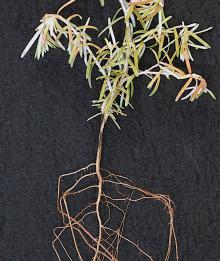See:
Greenhouse Plants, Ornamental - Gray Mold
Cause Botrytis cinerea, a fungus that can be involved in damping-off of young seedlings, a seedling blight in the greenhouse, field or cold storage. Current-season shoots of conifers may be infected. Cool temperature and moist conditions favor disease development. Airborne spores are easily dislodged and can rapidly spread the disease, particularly in greenhouses. Close tree or seedling spacing coupled with dense foliage and poor air circulation provide excellent conditions for gray mold. The fungus overwinters as sclerotia on infected twigs and needles.
In addition to Hemlock, Douglas-fir, spruce, coast redwood (Sequoia sempervirens), and giant sequoia (Sequoiadendron giganteum) are very susceptible to attack.
Symptoms Browning of needles, followed by development of masses of gray spores and mycelium. Curling, twisting, withering, browning, and dying of current-season shoot can also occur. May occur in the lower foliage first before moving up and killing needles and woody portions of the shoot. Damage may be similar to that caused by frost.
Cultural control
- Maintain greenhouse humidity below 90%.
- Improve air circulation in greenhouse or hoophouse structures by leaving end walls open during fall or by installing fans.
- Remove and destroy crop residue in production areas.
- Use proper fertility to maintain healthy growth.
Chemical control Use in conjunction with cultural controls. Rotate or tank-mix materials from different groups with different modes of action to avoid developing resistant fungal populations. Limit the use of any one group during the growing season.
- Astun at 10 to 17 fl oz/100 gal water is registered for container and field grown ornamental plants. Group 7 fungicide. 12-hr reentry.
- Chlorothalonil (Bravo Weather Stik or Ultrex, Daconil Weather Stik or Ultrex, Echo 720) for conifer nursery beds. Use Bravo Weather Stik at 1.5 to 2.75 pints/100 gal water. Group M5 fungicides. 12-hr reentry.
- Decree 50 WDG at 0.75 to 1.5 lb/100 gal water. Registered for outdoor, greenhouse, and nursery grown ornamentals, and forestry conifers. Group 17 fungicide. 12-hr reentry.
- Mancozeb-based products can be used as mixing partners and provide some protection. Group M3 fungicides. 24-hr reentry.
- Dithane M45 at 2 to 4 lb/A or per 100 gal water. 14-day PHI. Registered for use on Christmas trees.
- Fore 80 WP at 1.5 lb/100 gal water plus a spreader-sticker. Registered for outdoor or greenhouse use.
- Penncozeb 75 DF at 2 to 4 lb/A. 14-day PHI. Registered for use on Christmas trees.
- Protect DF at 1 to 2 lb/100 gal water plus 2 to 4 oz spreader-sticker. Registered for field, nursery and greenhouse grown plants including Christmas trees.
- Mural at 4 to 7 oz/100 gal water. Registered for conifer blights grown in many different sites. Group 7 + 11 fungicide. 12-hr reentry.
- OHP 6672 4.5 F at 10 to 14.5 fl oz/100 gal water plus another fungicide. Registered for evergreens grown in the nursery, greenhouse or landscape. Group 1 fungicide. 12-hr reentry.
- Orkestra at 8 fl oz/100 gal. Registered for evergreens grown in forest and conifer nurseries and plantations. Group 7 + 11 fungicide. 12-hr reentry.
- Pageant at 12 to 18 oz/100 gal water. Do not use with organosilicone-based adjuvants. Registered for forest and conifer nurseries, and plantations. Group 7 + 11 fungicide. 12-hr reentry.
- Palladium at 4 to 6 oz/100 gal water. Registered for conifers grown in many different sites. Group 9 + 12 fungicide. 12-hr reentry.
- Spectro 90 WDG at 1 to 2 lb/100 gal water. Registered for conifers grown in nursery, greenhouse or landscape. Group 1 + M5 fungicide. 12-hr reentry.
- Terraguard SC at 4 to 8 fl oz/100 gal water. Registered for nurseries including Christmas tree/conifer plantations. Group 3 fungicide. 12-hr reentry.
Biological control Use in conjunction with other control tactics such as thorough sanitation.
- LALStop G46 WG (Clonostachys rosea [formerly Gliocladium catenulatum] strain J1446) at 0.13 oz/1 gal water. Do not use with other products in the tank. 4-hr reentry. O
Reference Chastagner, G., Elliott, M. and Hulbert, J. M. 2021. Effectiveness of fungicides and biopesticides in controlling Botrytis gray mold on western hemlock nursery stock. Tree Planters Notes, 64:21-31.


